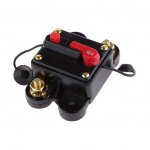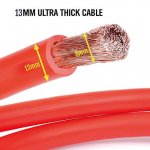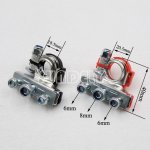A T-short from my favourite artists:
An externally hosted image should be here but it was not working when we last tested it.
Damn things are ESD sensitive out the wazoo. Latent damage issues.....I am not allowed to use them where I work. Manufacturing has banned them
We used tantalum caps a lot in cell phones in the 90's. When first TDMA (pulsed transmitter) phones came out we found that the tantalum caps across the battery right at the RF power amp would explode, or burst into flames when the transmitter was operated continuously.
Some experimentation with the new high K ceramics occurred, but they were quite piezoelectric, so you could hear the DC pulses being provided by the cap to the RF PA. We had to use 16 volt tantalum caps in a 7.5 volt phone and 10 volt caps in a 4 volt phone to avoid flameout!
When the cell phone boom occurred in the 1990's, there was a world wide tantalum shortage resulting in a long lead time for orders, and 20 cent caps costing $2. This led to some quasi legal mining in "conflict" countries and subsequent banning and quarantine operations by government agencies.
The reliability of a tantalum cap depends greatly on the purity of the raw tantalum used, and the adherence to quality control procedures during cap manufacture. It is possible to make a good, reliable tantalum with exceedingly low ESR, but a lot of junk got manufactured in the 90's, and possibly before.
Serious research by Murata, TDK and Taiyo Yuden had me testing ceramic capacitors for at least 6 months, and now you will not find a tantalum cap in a cell phone. The new stuff in non piezoelectric, and has an ESR far better than tantalum, so there is little reason to use a tantalum cap today.
Wavebourn, it is easy to tell which one is shorted. just substitute a high current supply for your standard one, and look for the cap that explodes.
I am not allowed to use them where I work. Manufacturing has banned them.
I use only axial military quality tantalums. Normally very expensive (Kemet or Dearborn), but we are very lucky to have a change to buy these cheap now as USSR surplus
Are you saving up for the right arm?A T-short from my favourite artists:
An externally hosted image should be here but it was not working when we last tested it.
Are you saving up for the right arm?
Not my arms, and if they were, they wouldn't be my arms as I am no fan of injecting unknown substances in my boy or beneath my skin.

Hope the footbolka, as T-shirts are called in Russia arrives before the Sw Postoffice decide to add a handling fee on imported goods.
...I am no fan of injecting unknown substances in my boy...
I'm sure your boy appreciates this as well.
This is a "hopeless" project. Started with something "universal" around an SN76477 and a simple 8-step sequencer (555+4017), but never got around finishing it. Then the Menta-Synth (Arduino in a Altoid box) but never got around and besides had do translate 18 pages of text ...
The Noise Toaster will hopefully do what the SN76477 does and may be easier to expand with some kind of ribbon controller or whatever later on.
The kid is 8 and I hope this will guide him into the sphere of cooooool music.
The Noise Toaster will hopefully do what the SN76477 does and may be easier to expand with some kind of ribbon controller or whatever later on.
The kid is 8 and I hope this will guide him into the sphere of cooooool music.
And just like clockwork I got $25.40 in credit because the items that I bought went on sale!Total: $65.26
But I'm a club plus member so if any of the items go on special I get credit back for the difference. Its a great deal.
Attachments
look at the axolotti board. It's pre built and can be programmed to be many different musical devices including a virtual modular synth. Programming is a GUI based "connect thee blocks" type of thing. You can plug in a MIDI keyboard to play yuor synth. I believe it cost about 60 Euros when I got mine. It's been a fun way to spend a rainy day.
YouTube
Axoloti
YouTube
Axoloti
There was an extremely simple mouse trap, that came out on the market a few years ago here in Sweden.
It was just a box with a hole, slightly bigger than a mouse's head and a tiny sawblade at the lower part of the hole.
The idea was that the mouse should peep into the hole, shake his head saying "No cheese! No cheese!" and saw his head off.
The Animal's Rights Association went ballistic and a new model was soon introduced. The trap looked the same but inside the box, there was a cheese to the left and a wiener to the right and being undecisive, the mouse would turn his head back and fro saying "Cheese? or hotdog? cheese .. or hotdog ...??"
It was just a box with a hole, slightly bigger than a mouse's head and a tiny sawblade at the lower part of the hole.
The idea was that the mouse should peep into the hole, shake his head saying "No cheese! No cheese!" and saw his head off.
The Animal's Rights Association went ballistic and a new model was soon introduced. The trap looked the same but inside the box, there was a cheese to the left and a wiener to the right and being undecisive, the mouse would turn his head back and fro saying "Cheese? or hotdog? cheese .. or hotdog ...??"
Mushy peas are NOT edible in any shape or form !!!!!!!!
.
I love 'em. There was a pub nearby in Carp called The Swan at Carp; they made great fish and chips served with a side of mushy peas.
Great with a bit of pepper!
- Home
- Member Areas
- The Lounge
- And what did we buy today?




